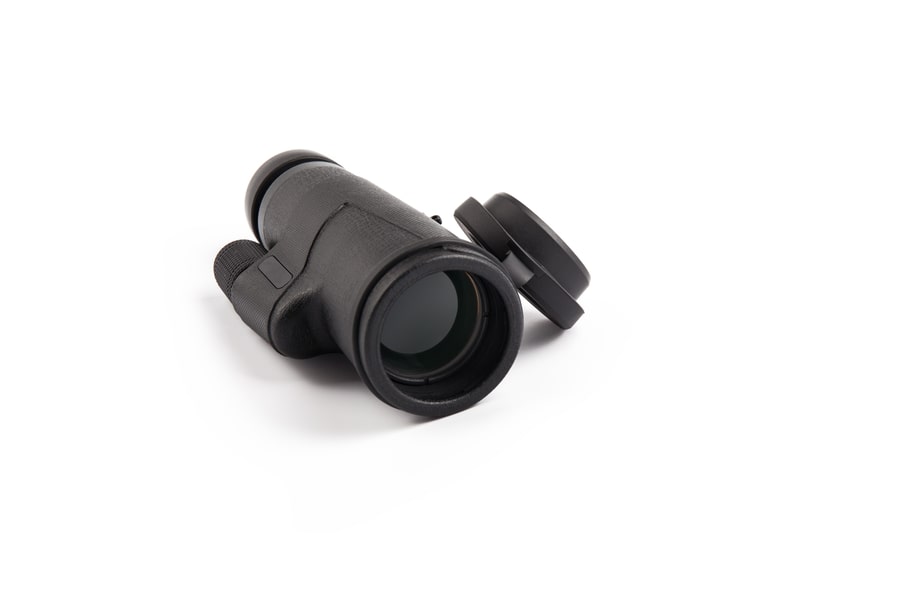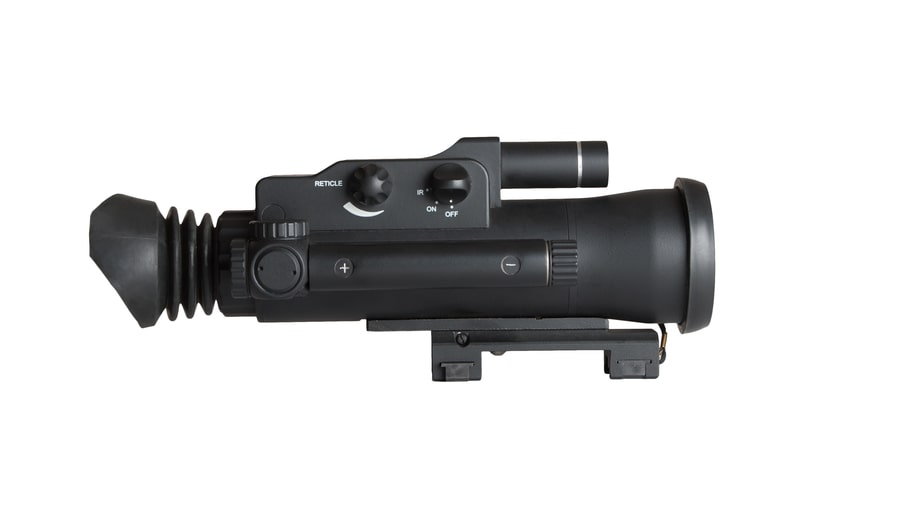Choosing the best monocular telescope for stargazing, camping, hunting, and other activities doesn’t have to be complicated. You only need to familiarize yourself with different types of monoculars, their features, and prices to make an informed decision and get the best device for you and your needs.
That’s why we prepared this guide on how to choose the best monocular telescope for a specific activity. Without further ado, let’s explore the world of monoculars.
What Is a Monocular Telescope?
A monocular telescope is an optical device used to magnify the images of remote objects. It does that by passing light through the lenses or prisms. Monocular telescopes are typically half the size of a pair of binoculars, making them less expensive and easier to carry around. Moreover, monoculars offer one two-dimensional image, while a pair of binoculars provides two parallax images.
Who Should Use a Monocular Telescope?
Monoculars are ideal for everyone who needs a lightweight and compact optical device. Moreover, they are perfect for people who see only with one eye. So, if you have difficulties with using both eyes or you need something compact and low-weight, a monocular might be the best optical device for you.
Monocular Telescopes Are Great for a Myriad Activities
Monoculars come in handy for many activities. For example, they are perfect for viewing, scouting, and scanning while camping, hiking, and hunting but aren’t restricted just to sports activities. You can use a monocular telescope for watching concerts, operas, ballet, sports events, and other performances. Many people use them for bird watching and nature observing too.
Specific monoculars, such as thermal and night vision, are typically used in law enforcement and military operations. However, many night hunters enjoy using night vision and thermal monoculars because they can help them spot prey more effectively than standard ones.
Choose the Best Monocular Telescope Based on Type

Different monoculars will suit different activities. To choose the best one for you and your intentions, you need to familiarize yourself with monocular types. Without further ado, let's dive right in.
Standard Monoculars
Classic monoculars are made for everyday use. They typically come with lenses or prisms for standard functions only. They perform best in light conditions, making them excellent choices for occasional nature observers, hikers, golfers, etc.
Digital Monoculars
A digital monocular is an optical device that uses digital image processing to magnify and enhance an image. These devices have various functions and are often used as rangefinders and night vision assistance. Some digital monoculars also include standard lenses, while others can output images to a digital storage device to archive them.
Night Vision Monoculars

As the name suggests, night vision monocular telescopes are primarily used at night, mainly for surveillance activities and night-time hunting. This type of monocular is excellent for locating targets in dark conditions.
There are two kinds of night vision monoculars: infrared and thermal imaging monoculars. Both can be used in the daytime by turning off the infrared or thermal imaging mode. However, they perform best at night.
- Infrared monoculars: Infrared monoculars use infrared wavelengths to illuminate objects in the dark. Some infrared monoculars have a visible red light, whereas others don’t. Consider that when choosing your device because red light can easily scare off animals.
- Thermal imaging monoculars: Thermal imaging monocular telescopes are valuable at night because they can help you spot animals good at camouflaging and hiding. They detect heat to form images of objects in dark conditions. They don't have visible red lights, so you won’t have to worry about deterring your prey.
Compact Monoculars
Although monoculars are already compact, some are smaller than average. A couple of inches smaller than standard monoculars, these can easily fit into your purse or pocket. Their only disadvantage is lower magnification power and lens diameter. Nevertheless, they are excellent for simple viewing activities despite their less powerful specifications, such as watching concerts. Also, they are typically inexpensive.
Choose the Best Monocular Telescope Based on Cost
The best monocular telescope for you doesn’t have to be costly. Affordable monoculars can also offer excellent image quality and performance. However, more expensive monoculars often provide specific features and more powerful specifications and are more suited for invested users, rather than casual watchers.
Below are the monocular pricing details to help you choose the best one for you and your activities.
- Under 60 dollars: Monocular telescopes under 60 dollars can be decent enough to let you observe nature even without powerful specs. They are a good choice if you enjoy intense outdoor activities and don’t want to worry about scratching or breaking an expensive device in the process.
- From 60 to 160 dollars: Monocular telescopes within this price range are high-powered devices that deliver optimal brightness and clarity. They often have waterproof features, making them ideal for long hours spent outdoors in changing weather. Also, they are more durable than their cheaper counterparts. The best monoculars for birdwatching will often be within this price range. These monoculars are best for people who want to use them frequently for both outdoor adventures and indoor observations.
- 160 dollars and up: More expensive monoculars are ultra HD and offer incredibly clear images. They have outstanding prism and magnification powers and are best for professional uses. They are also an excellent choice for invested users.
Consider Features when Choosing the Best Monocular Telescope for You
Magnification, lens diameter, eye relief, and image quality are vital features to consider when choosing the best monocular for you and your activities. Learn more about them below.
Magnification
You will see numbers on a monocular telescope that indicate its magnification power, for example, 10x50. The first number tells the observed object will look ten times larger. The second number means the objective lens is 50mm in diameter. Remember that higher magnification doesn’t mean an image of better quality, as it will narrow your field of view and produce a more unstable image.
That’s why you need to know what you will use a monocular for and how much magnification you want. Typically, monocular telescopes feature a magnification of 6x to 10x. These are the best monoculars for optimal image quality. Everything above that may create an impaired vision as even a twinge can cause instability and loss of target.
Lens Coating and Diameter
When choosing the best monocular telescope, you need to consider lens coating and diameter. Coated lenses enhance image clarity and brightness, and they are great for use during cloudy weather. Larger lenses are great for low-light conditions as they gather more light.
Eye Relief
Eye relief is a measure of the distance your eye can be away from the lens so you can see well. That typically isn't an issue unless you wear glasses or contact lenses. You'll need a monocular with more notable eye relief if you do.
Image Quality
Image quality is one of the most vital factors to compare between monocular telescopes. You have to consider clarity, brightness, and viewing range to do that. Clarity refers to how sharp the image will appear, whereas brightness affects the ability to see in different light conditions.
Viewing range indicates how far your monocular telescope will allow you to see, and it’s affected by magnification. A narrow field of view allows you to focus on a small area in detail. On the other hand, a wide field of view helps you see the whole picture. The best monocular for most people is the one that offers the middle ground of these two types of field of view.
Other Things to Consider when Choosing the Best Monocular Telescope
Consider additional features besides the ones we mentioned above, depending on what you will use your monocular for. These include size, materials, prisms, and specific properties.
Sizes
The size of the monocular matter as bulkiness can affect the intent of its use. Note that larger monoculars offer a better view, while smaller monocular telescopes are more portable. So, before choosing yours, understand what size is more suitable for you and your activities.
Materials
The materials will determine the monocular's durability and resilience. Most monoculars are made of metal or plastic, and sometimes they are coated with rubber for shock absorption. Getting a monocular made of more robust materials and shock-absorbing rubber is crucial if you spend time in harsh and challenging terrains. Otherwise, you can go for regular monoculars.
Prisms
Monoculars with poor prism quality produce dim and blurry images. Your safest bet is choosing a device that features either a Roof or Porro prism. Roof prisms cost more and offer a brighter color image quality, whereas Porro prisms provide a better 3D sharpness and are cheaper.
Special Features
Night vision, shock absorption, and water resistance are only some of the special features a monocular telescope can have. Go for a device with specific properties that match your activities. For example, the best monocular telescope for the phone will be compatible with smartphones and allow you to capture beautiful photos of desired objects.
What Is the Best Monocular Telescope for You?
After reading this article, you have an idea of what type of monocular telescope will be perfect for you. You also know which features to consider for different activities, such as hunting and bird watching.
Circuit’s monocular is one of the best monoculars with a magnification power of 10x. It’s compatible with phones, tablets, and more, making it an ideal on-the-go device for travelers, hikers, stargazers, etc. What’s more, it’s water- and shock-resistant, making it exceptionally durable. Feel free to check it out and get yours today!